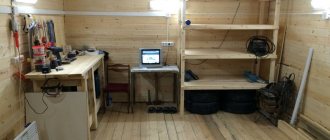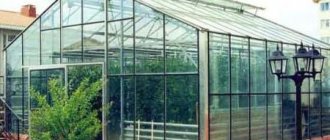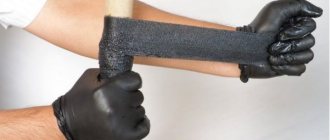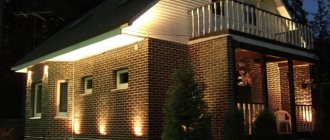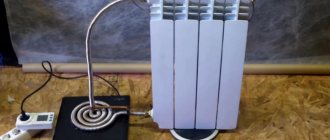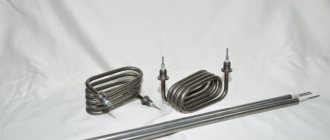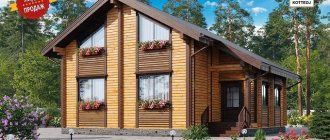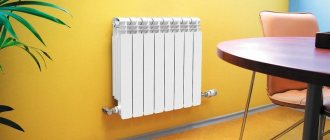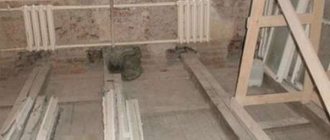Which houses are best suited for heating devices?
Depending on the building materials, a temporary dwelling may or may not be suitable for heating. For example, wooden houses built from panel panels cool down very quickly.
Such a structure must be additionally insulated. Don’t forget about fire safety when installing heating in a wooden country house. Another thing is houses built of brick, shell rock or concrete . They are permanent buildings and are ready for year-round visits. The choice of heating scheme in such houses depends on the communications passing nearby.
Features of choice
To correctly choose the most inexpensive heating method, you need to answer some questions that can determine what is best suited in each specific case.
When choosing the cheapest type of heating for a private home, you must adhere to certain requirements:
- Determine what the concept of savings consists of: the low cost of the initial installation of equipment or its operation.
- Decide how the living quarters are used: periodically or regularly. This determines how the heating will work: all the time or turn on only while the owners are in the house.
- Decide on the location of the premises and their area.
- Decide what type of fuel is most convenient to use in the heating system.
Suitable heating options for a summer house
Conventionally, they can be divided into three types:
- oven;
- water;
- electric.
Modern stove heating is achieved using a cast iron or steel stove .
a furnace made of refractory bricks , since it should be taken into account at the design stage and installed together with the construction of internal walls.
If you have to choose heating in your dacha without gas, then this option turns out to be the most economical. The advantage of this type of heating is the ability to heat the room to an optimally comfortable temperature in just 40-50 minutes. Stove heating has disadvantages: it is necessary to periodically (approximately every 4-6 hours) add fuel and clean the ash pan from combustion products; you also need to control the draft.
However, this device has undoubted advantages: simplicity and speed of installation, no need to worry about equipment failure, freezing and rupture of pipes, as in water heating.
The second type is water (steam) heating . In terms of comfort and design, it can be compared with a city one. The principle of water country heating is that the coolant - hot water (or antifreeze) is preheated in the boiler - passes through pipes into radiators or convectors and releases heat, heating the rooms. The disadvantages of such heating are the complexity of the circuit and the need to purchase expensive equipment.
The advantages of this type of heating: comfort of use and the ability to choose one of the available boilers:
- gas;
- electric;
- solid fuel.
It should be noted that gas heating boilers for dachas, although preferable, require mandatory approval before installation from the gas service.
The simplest type of country heating is electric . This is implemented by installing heaters, convectors or warm infrared floors. Pros: their installation does not require major repairs, the equipment does not require maintenance, it connects and works as needed. Cons: in case of power outages, it is better to have an alternative heat source, for example, the same stove.
Simple heating of a country house: without gas or electricity
Heating a home with electricity is expensive and unreliable . Using gas is cheaper, but it is not always possible . Then you have to look for other options.
There are several modern alternative sources : energy from the sun, underground resources or an ice-free reservoir. But their installation is quite expensive and complicated. a traditional option is often chosen for a dacha .
Pechnoe
It has been known for quite a long time , but remains relevant to this day. There are many variations of stoves. They can heat the entire house or a single room. Sometimes they are connected to a water heating system. Stoves not only heat, but also cook food .
Fuel burns in the combustion chamber. It heats the walls of the stove, which release heat into the house.
The following materials are used:
- brick;
- cast iron;
- stainless steel.
The brick takes a long time to heat up, but it also takes longer to release heat. To maintain a comfortable temperature at the dacha, 1-2 heatings per day are required . Steel furnaces heat up quickly and cool down just as quickly. Cast iron ones also heat up quickly, and in terms of heat transfer they occupy an intermediate place between other varieties.
The following is used as fuel:
- firewood;
- coal;
- pallets;
- fuel briquettes.
Advantages and disadvantages
The advantages of heating a dacha with a stove include:
- Autonomy . There is no dependence on gas and electricity.
- Suitable for houses where people do not live permanently.
- You can also cook in the oven .
There are the following disadvantages:
- Requires space to store fuel.
- Brick stoves are quite massive , and it is advisable to lay them together with the house.
- Less heating efficiency.
- If the water circuit is not connected, far from the stove will be cooler.
- It is necessary to make a chimney .
How to choose the right heating system for your dacha
The first step is to determine the availability of fuel. If there is a gas main nearby, it would be a sin not to take advantage of it. Gas is one of the cheapest types of fuel. Accordingly, gas heating for a summer house is the best option in terms of quality and affordability.
If the networks do not pass close, then solid fuel and electricity remain. It is better to give preference to either a cheaper or safer type. Much depends on the materials from which the house is made.
For example, it is unsafe to install stove heating , since materials located near the stove may ignite. At the same time, infrared floors are best installed under laminate, since wooden floors have high heat-insulating properties. In addition, they dry out from heating and become deformed over time.
We can draw conclusions:
- For a house made of brick or concrete, water or stove heating ;
- for a wooden house it is better to install water or electric heating . When using the oven, you should take safety precautions and carefully isolate it from heated metal surfaces.
Gas equipment: heaters and convector
In addition to firewood and electricity, there is another source of thermal energy that many summer residents successfully use - gas. If gas is not supplied to your dacha, you can use liquefied gas (it is supplied in cylinders): currently, many heating devices can operate on any of these types of fuel. Equipment that runs on gas in a country house is used:
- infrared gas heater,
- gas convectors,
- catalytic gas heater.
The operating principle of the first two devices is no different from their counterparts powered by electricity. But the action of a catalytic heater is based on the interaction of burning gas with a special catalyst plate. During combustion, the gas, thanks to the catalyst, is oxidized. The oxidation reaction is accompanied by the release of a large amount of heat, which warms the room. Gas consumption is quite small, because the oxidation reaction depends simply on combustion, and not on its power.
Advantages of gas equipment:
- fairly low gas prices;
- ease of installation, mobility;
- rapid heating of the room;
- reliability.
Not without its drawbacks:
- when using gas cylinders there is always a risk of gas leakage;
- at low temperatures there may be a problem with turning on the gas heater;
- infrared gas heaters are quite expensive, and if they break down, repairing them will also cost you a pretty penny;
- When gas is burned in convectors, combustion products are formed, for the removal of which a chimney is required;
- Catalytic heaters have practically no combustion products, but they have another disadvantage - a limited service life. When using low-quality gas, it is greatly reduced.
Stove heating: installation rules
This heating installation in a country house has some limitations. It is best to install a cast iron firebox in utility rooms or living rooms, choosing walls at least 500 mm thick adjacent to the interior rooms. It is not recommended to install stoves in bedrooms to avoid carbon monoxide poisoning. It is not advisable to install the firebox in a draft, between adjacent windows or doors: otherwise it will start to smoke. It is not recommended to hammer into a wall if there is no chimney; it is better to complete it.
It is correct to place the firebox on a brick bed laid in three rows, especially if it does not have a stand. A chimney made of sheet material or cast iron is installed above the stove. To avoid fire, you need to cover the pipe with thermal insulation at the points of contact with the ceiling and roof. Depending on the model, such a stove heats an area from 15 to 90 square meters. m. It can be installed in one day, if you do not use decorative finishing.
Alternative options
If the owner of a summer house decides to refuse to heat the property with gas cylinders, then it is worth choosing universal electric infrared emitters. The units heat surrounding objects, which gradually release the accumulated heat into the room. It is best to install heaters on the ceiling to achieve maximum effect.
Convectors have high efficiency, affordable prices, and convenient design. The device can be placed anywhere in the room. The unit can be fixed with brackets to the wall surface or stand on the floor on built-in legs (wheels).
It is possible to heat the house with electric ventilation devices. They are quite cheap and heat the room faster than all analogues. Warm air from the spiral is supplied to the room using a flow of oxygen. Disadvantages: air drying, noisy operation.
Popular infrared emitter
Water heating of a country house
This type of heating is the most comfortable due to the fact that the heat emanating from the radiators is distributed evenly throughout the room. It is advisable to choose it for houses with an area of 100 m2 or more , when stove heating is not enough and electric heating is expensive.
The do-it-yourself dacha heating scheme boils down to the following: water is heated in the boiler, which begins to circulate with the help of a pump, flowing through the pipes into the radiators. To prevent the liquid expanding from heating from rupturing the pipes, it is necessary to connect a container to the system - an expansion tank of an open or closed (membrane) type.
It is possible to install a water heating system without a pump - of the forced type, but it is less reliable and not justified, since heating the room with its help is many times slower. Sometimes it takes a day for the room to get a little warmer. Therefore, we will not consider it.
So, to set up the system you will need to purchase:
- radiators;
- pipes suitable for them;
- expansion tank;
- pump;
- shut-off valves, corresponding keys;
- gas, electric or solid fuel boiler depending on the availability of fuel.
The most suitable heating radiators for summer cottages are aluminum or biometallic . They weigh little and heat up quickly. They are easy to transport with your own transport and connect to polypropylene pipes, which look decent, are inexpensive and do not require painting.
Installation recommendations
When placing radiators on brackets, it is necessary to maintain a distance of at least 70 mm to the window sill, 100 mm from the floor and 30 to 50 mm to the wall. The film is removed from the batteries after installation. For aesthetic reasons, it is better to install supply pipes level. The expansion tank is located next to the boiler, the pump in front of it.
It should be taken into account that when the house is not heated, the water in it will freeze, which can lead to rupture of pipes and failure of the system. To prevent this from happening, it is recommended to either drain the water when leaving or fill the containers with antifreeze.
How to plant black currants: planting diagram, tips + video
Growing black currants is not so difficult.
Every person can cope with this task. But how to plant black currants correctly? You need to follow the advice of professionals. 2-year-old seedlings are considered the best option. The length of their roots should be 15–20 cm, while the ground shoots should be about 30–40 cm.
1. Planting black currants in spring2. Planting black currants in autumn3. Planting scheme4. Video
If you still decide to use annual seedlings, then pay attention to their root system. She must be very well developed
If you wish, you can grow seedlings yourself, but to do this you need to have good knowledge about the propagation of berry bushes.
Planting black currants
Tip: Black currants should be planted in spring or autumn. The most suitable time of year for this is considered to be autumn. In spring, black currants are planted in those regions where little snow falls in winter.
Currant bushes grow very well on fertile or light loamy soils. On marshy soils, currants will grow very poorly. This applies not only to currants, but also to raspberries.
Currant bushes are planted in rows. The distance between them should be about two meters. Shrubs must be planted in previously prepared holes, the depth of which should be at least 50 cm. The diameter of the hole should be about 40 cm. The hole can be larger. In this case, the bushes will grow better. It is best to plant seedlings at a slight angle, leaving a few branches underground. The very next year you will receive a lush bush.
Many people prefer to buy blackcurrant seedlings from nurseries. But they need to be transported very carefully. It is necessary to monitor the condition of their root system; it should be in a humid environment. To prevent the roots from being damaged during transportation, they need to be wrapped in thick cloth, after being soaked in a clay mash.
Electric heating installation
Installation of heaters and convectors
The easiest and fastest way to keep warm in a country house is to turn on the convector or infrared emitter . A very good option for a summer house is an oil heating radiator. These devices very quickly raise the room temperature to a comfortable level.
One could stop at this equipment if it were not for health concerns. The fact is that in a cold room your feet freeze more than outside. warm floors in the house . They allow you to warm up much faster after a long stay in the fresh air, and therefore there is less chance of catching a cold.
Installation of heated floors
You can install infrared heated floors at any time of the year, even on old flooring. Using this method, installation of heating for a dacha is carried out without much difficulty. To do this, you need to purchase infrared film, heat and waterproofing, a thermostat, and a coating (preferably laminate). If you do not want to contact specialists to install such floors, then you should follow these steps:
- clean the floor surface, it must be perfectly flat;
- install a thermostat in the wall;
- lay thermal insulation and secure it with construction tape;
- lay the film strips in accordance with the instructions (the area where the furniture will be should be left without an emitter);
- fasten them together;
- Insulate cut areas with bitumen tape;
- connect electrical wires to the edges;
- bring them to the thermostat; check the system for serviceability;
- lay waterproofing;
- cover the floor with carpet or laminate.
Portable and portable systems
Suitable for heating small cottages in winter. Classic country houses are often designed for seasonal living, and the installation of complex equipment requires large investments.
In such a situation, it is better to use portable models of electric heaters. Infrared panels and oil batteries are in greatest demand. They have diametrically opposed principles of action. An oil heater heats the air, and an infrared panel blasts surfaces with infrared rays. The efficiency indicator reaches 93%.
Devices in this category have the advantage of being easy to move from room to room, heating only living spaces. This option is appropriate when the dacha is used seasonally.
Installation of IR panels on the ceiling
Recommendations on how to save on heating a country house
It has been observed that heat leaks affect the speed and efficiency of heating rooms. Up to 20% of the heat usually escapes through old wooden double-glazed windows. Through cold walls - up to 40%, through doors - up to 20%, through the floor - 10%. Accordingly, if before the onset of cold weather you fix leaks and insulate the walls, then within an hour you will be able to feel in a country house just like in a city apartment.
And further. The most economical heating for a summer house in terms of fuel consumption is gas . Therefore, if it is possible to connect to the highway, then it is better to choose it as a priority.
Universal liquid fuel models
More often, specialists have to install high-quality air-type heating for a summer residence, since a comfortable temperature is maintained in all rooms. Boilers running on diesel fuel, fuel oil, waste oil, or kerosene cannot function as an independent unit.
Therefore, the master must provide for a reliable connection of the equipment to the heating system of the wood-burning cottage with batteries, radiators or registers that are located in each room. It is necessary to provide for the availability of free space for installing the boiler and prepare a site for energy storage.
The room must be ventilated and equipped in accordance with fire safety rules.
For a country house, you can choose systems with one or two circuits. The second option is relevant when, in addition to heating, you need to provide water heating for domestic needs. The dual-circuit system can be equipped with a boiler or a flow-through heater. According to their design, liquid fuel boilers are either floor-mounted or wall-mounted.
Wood burning stove
Let's start with stove heating. For a country house, you can purchase a steel or cast iron stove. Cast iron structures are more valuable. They hold heat better and have a longer service life. The stove heats up quickly.
When using stove heating for your dacha, you will have to provide a smoke exhaust structure and connect the potbelly stove to the chimney. Firewood or coal will have to be constantly added. If there is no fire in the stove, it cools down quickly.
Sometimes the heat capacity of such a furnace can be increased by lining its inside with ceramics or making some heating surfaces ribbed. Cast iron stoves are heated with coal or wood. Sometimes you will need to remove ashes and clean the chimney.
Savings when designing a home
Economical heating systems can operate as efficiently as possible only when the optimal temperature regime is organized. When planning a house, you need to take into account that the rooms that border the outer wall cool much more in winter, unlike those located in the center.
Therefore, if you provide for the location of rooms that need a higher temperature, and rooms where the temperature can be lowered, then the heating system will work much more efficiently and not consume a large amount of energy:
- Rooms where a temperature of at least 22-27 degrees is required: children's room, bedroom, living room, bathroom.
- Rooms where a lower thermal regime is possible: office, kitchen, pantry, dressing room.
Thermal insulation of the building
When organizing economical heating of a building, it is necessary to remember about high-quality thermal insulation of the house. Even the most efficient heating system will run idle if the heat it gives off starts to leak out into the street. Even when there are no drafts on walls without thermal insulation, not only will the air begin to cool, but condensation will also accumulate. Cold floors can reduce the operation of any heating circuit to zero. Poor quality doors and windows will also contribute to this.
Of course, the lower the temperature in the area where the house is built, the more you will need to spend on its thermal insulation. But a well-insulated building will require half as much heating energy as a conventional house. Thus, savings on fuel during any heating option will be quite significant.
This factor must be taken into account at the planning stage of the house, selecting materials with high thermal insulation rates for its construction. But an already constructed building can also be successfully insulated. Today there are a large number of different insulation materials on the market that have low thermal conductivity and are suitable for DIY work.
The following insulation materials can be used:
- glass wool;
- Styrofoam;
- polyurethane foam;
- expanded polystyrene;
- mineral or basalt wool;
- expanded polystyrene.
Each of the materials has certain advantages and disadvantages, and the possibility of using any will depend on the installation location and the material of the walls. Experts know all these nuances very well and will be able to recommend which insulation to choose in each specific case.
Additional features
Thanks to modern devices, your home can be made even more economical using the following devices:
- Geothermal heating systems, solar panels and condensing boilers. These devices help save money because they can supply cheaper or even free energy. But these systems require quite significant initial costs, which can take a long time to pay off.
- Programmer. Using the device, you can automatically adjust economical heating, setting the required thermal regime by day or hour. For example, when residents are away from home, you can set the temperature to 15-16 degrees, and by the time they arrive, increase it to 23-25 degrees. Lowering the temperature by one degree approximately saves up to 7% of energy resources.
Choosing the most economical heating option for your home is quite difficult.
Heating can actually be inexpensive, but you just need to take the choice of a particular technology with the utmost responsibility, find out all the main advantages and disadvantages, spend a lot of time studying all the information and monitoring construction market equipment. In contact with
Main types of fuel
An economical boiler should be selected taking into account the minimum cost of thermal heating, so first you need to decide what is the cheapest fuel for heating . At the same time, its availability should consist of several factors:
- cost of fuel;
- its uninterrupted supply.
The last factor is the main one when choosing. The most commonly used types of fuel are:
- briquettes;
- firewood;
- diesel fuel;
- coal;
- gas;
- electricity.
When choosing a boiler, you need to take into account the thermal capabilities of any type of fuel, as well as its heating costs. Thermal capacity will determine how efficiently it releases thermal energy during combustion.
Taking into account the decrease in the thermal capacity of the fuel, the following series can be distinguished:
- electricity;
- gas;
- diesel fuel;
- coal;
- pellets and firewood.
The cost of fuel is different in all areas. But on average, if any type is available, gas is considered the most economical. Firewood and coal cost twice as much, and electricity is the most expensive.
Installation of heating devices
Initially, the boiler is installed, since it is best to supply heating to consumers from it. If possible, a separate room is selected for the boiler, where additional supply and exhaust ventilation is also installed. If the boiler runs on coal, this will prevent coal dust and soot from entering the interior. But the boiler can be installed at the dacha in another place, for example, in the hallway, in the kitchen. You can do the work yourself, or invite specialists for this purpose.
Radiators
Radiators are installed under windows after their power has been previously calculated. Their installation is simple, you can easily hang them yourself. To do this, you need a good hammer drill, mounting hardware and a radiator. The fastening must be reliable, able to withstand not only the weight of an empty radiator, but also one filled with water, and additional loads.
Pipes
The routing of pipes begins from the return, moving in the direction from the boiler, maintaining the angle of inclination of the pipes. The supply pipe must be higher than the return pipe. At the final stage, all heating devices are connected. The connection method depends on the choice of pipe material.
System pressure
If the system operates under pressure, then it is necessary to monitor the readings of the pressure gauges. Normal operation of the system is indicated by the absence of a decrease in pressure within 15 minutes of no more than 0.2 kgf/cm², then the test is considered successful. The installation ends with a thermal test, during which the quiet operation and uniform heating of the heating devices are checked, and leaks are eliminated. At the end of the heating season, the chimney is checked and cleaned.
Warm cottage rules
It is quite possible to insulate a summer dacha so that you can comfortably survive the winter holidays there, even “with a couple of heaters”. There are ways that do not require large financial investments. For this:
- Insulate the windows, if necessary, adjusting the clamping mechanism, turning the hinge tool, replacing the glazing bead and seal, foaming the cracks under the window sill or insulating the slopes. Even if you simply glue a layer of insulation around the perimeter of the window and seal the joints with improvised materials, it will be warmer. As a last resort, you can simply seal the window with a piece of polyethylene.
- Seal the gaps between the doors and the frame with sealant, and add additional insulation by hanging a thick curtain.
- Insulate the ceiling by covering it with sawdust or slab insulation, or install foil insulation inside the room;
- Insulate the floor by attaching foil insulation around the perimeter, or covering the entire floor area with it. Or insulate the underground by spreading loose insulation onto a membrane that is laid directly on the ground. Or insulate according to all the rules using bars and mineral wool.
- Insulate the walls inside the house with reliable material.
On FORUMHOUSE you can read about different options and advantages of insulating a wooden floor, types and features of interior wall decoration. Find out from the article on our website about another good way to quickly insulate a dacha - make a heap: this can become a worthy part of the New Year's insulation strategy. Watch our video on how to convert a summer cottage into a home for permanent residence.
Subscribe to our Telegram channelExclusive posts every week
